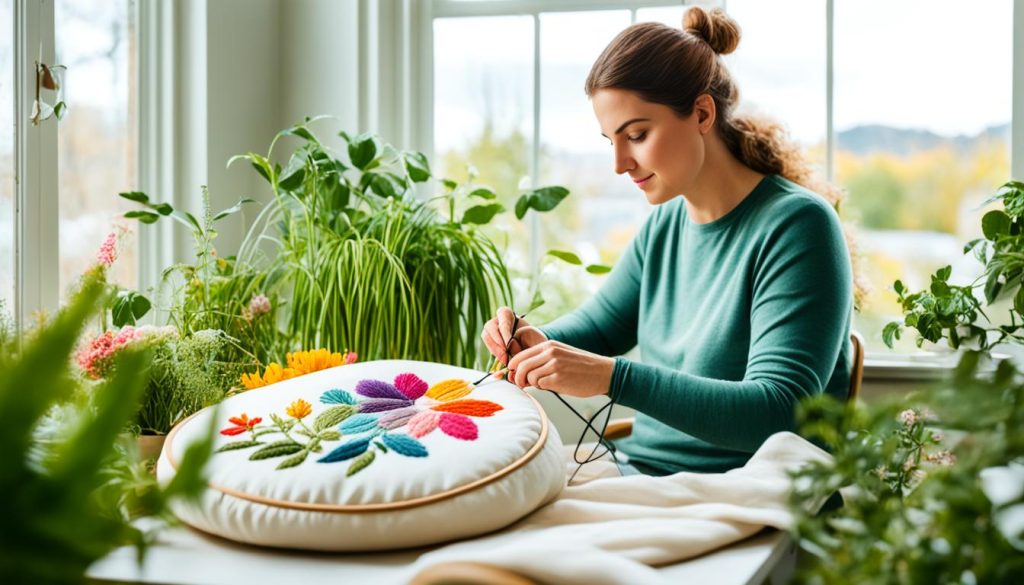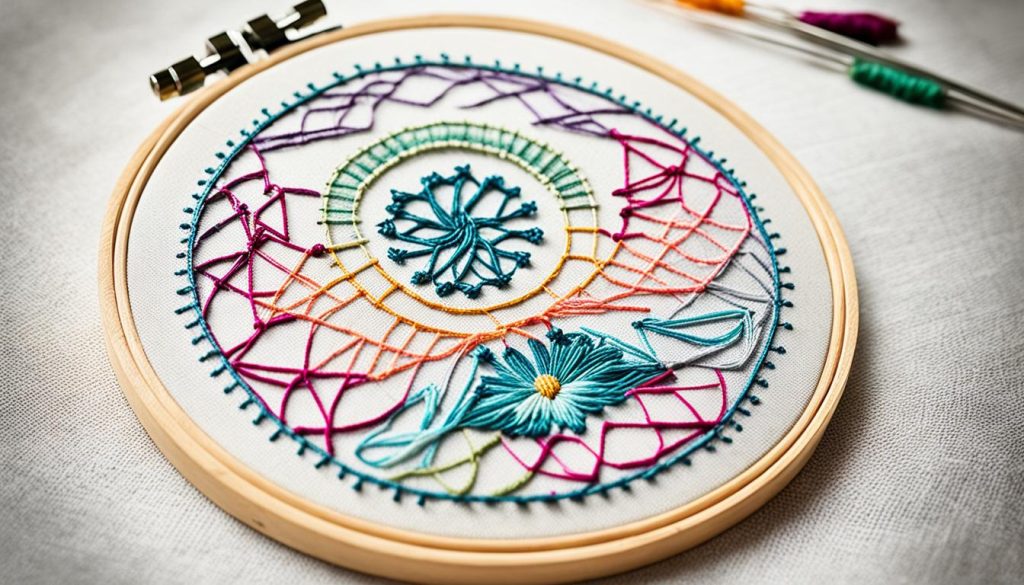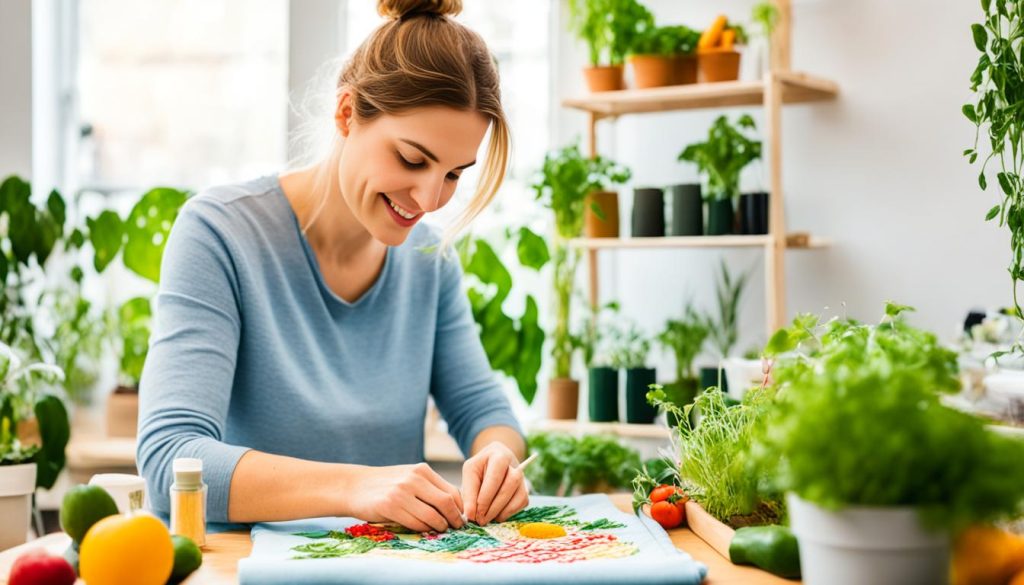Have you ever noticed how embroidery, an ancient art from 30,000 BC, still captures hearts today? It was once thought of as a job for boys only, done under male guidance in some places. But now, everyone enjoys it. Both men and women find joy in this craft. So, why learn embroidery in today’s tech obsessed world?
Embroidery is more than just a fun way to pass the time. It’s a skill that offers many benefits. This ancient craft lets you make beautiful things on your own. But it also teaches you important life lessons such as being disciplined and patient. Plus, it helps you improve your eye-hand coordination. This craft is a great way to start if you’re looking for a new way to be creative.
What’s great about embroidery is that it doesn’t cost much to start. You only need a few basic supplies. With simple stitches like the cross-stitch, you’re on your way to creating amazing pieces. This could lead to selling your work or even fixing clothes for others. By spending time on embroidery instead of social media, you could save lots of time. Imagine, almost 9 hours a week. That time is enough to whip up some unique presents or mend someone’s clothes.
No matter who you are, there’s a lot to gain from doing embroidery every day. It’s a simple way to become better at managing your time. Plus, the things you learn will stick with you for life. Set a few minutes aside each day for stitching, and you’ll see big improvements. Whether you want to boost your creative thinking or just feel a sense of accomplishment, embroidery is perfect for that.
Key Takeaways
- Embroidery fosters creativity and teaches important life skills.
- It is a budget-friendly hobby that requires few supplies.
- Embroidery improves fine motor skills and eye-hand coordination.
- Short, daily stitching can help you get more done.
- Trading some social media time for embroidery can free up many hours each week.
The Benefits of Learning Embroidery
Embroidery is more than a hobby; it’s both calming and fulfilling. It offers benefits such as stress relief. Plus, it teaches important life skills.
Stress Relief and Mental Health
Embroidery is a top choice for reducing stress. It can lower blood pressure and heart rate. Studies show that creative activities, like embroidery, lower stress and anxiety. Considered a mental health craft, it lets you share your feelings and thoughts through beautiful designs.
“Engaging in embroidery can actively reduce cortisol levels, the hormone responsible for stress signals in the body.”

Embroidery is not just a hobby; it’s art therapy. It makes you feel good and confident when you finish a project. It also promotes focus and mindfulness. This can help you be happier and calm, especially in tough times like during quarantine.
Building Patience and Perseverance
Embroidery also helps you become more patient and determined. Working on detailed designs teaches you to stick with something. This is important in our busy lives. By working on a piece, you learn to value the process. This brings a lot of satisfaction.
During World War I, soldiers used embroidery to recover from trauma. The craft helped build their resilience. It’s known to improve brain health and help stroke survivors too. Embroidery is more than just a craft; it’s a way to heal.
Being a part of embroidery groups can make you feel better about yourself. You make friends and improve your communication. This makes learning different techniques fun and sociable.
| Benefit | Impact |
|---|---|
| Stress Relief | Lower blood pressure, reduced cortisol levels, enhanced mindfulness |
| Mental Health | Improved self-worth, reduced anxiety, emotional expression |
| Patience & Perseverance | Enhanced focus, resilience, and brain health |
| Social Connections | Improved communication skills, stronger friendships |
Learning embroidery brings many benefits. It enhances your health, patience, and creativity.
Types of Embroidery Techniques You Can Master
Embroidery offers a wide range of techniques. Every method has its own look and use. You can choose from traditional stitches like chain and stem stitch to easier ones like the long stitch. Hand embroidery and machine embroidery are the two main options, each having its benefits and beauty.
Hand Embroidery vs Machine Embroidery
Deciding between hand and machine embroidery depends on what you want to create. Hand embroidery adds a personal touch and showcases the maker’s talent. In contrast, machine embroidery is great for speed and accuracy, making it perfect for big or intricate projects.

Popular Styles: Cross-Stitch, Long Stitch, and More
Some beloved embroidery types are cross-stitch and long stitch, along with detailed patterns. Cross-stitch patterns stand out for their beauty and ease of learning. The long stitch excels with its straightforwardness, perfect for those starting. Many styles can be found in embroidery kits that include everything needed for a project.
- Essential stitches include the chain stitch, French knot, and stem stitch.
- Advanced stitches such as the bullion knot bring intricate detail but need practice.
- Newcomers often begin with embroidery kits designed for learning.
- Decorative stitches like the lazy daisy and scallop create unique designs.
| Technique | Stitches | Best Use |
|---|---|---|
| Cross-Stitch | Running Stitch, Backstitch, French Knots | Creating beautiful patterns and images |
| Long Stitch | Split Stitch, Woven Wheel Stitch | Great for covering large areas with neat lines |
| Lazy Daisy Stitch | Stem Stitch, Feather Stitch | Perfect for adding floral and natural designs |
| Woven Wheel Stitch | Couching Stitch, Bullion Knot | Ideal for creating detailed flowers and textures |
By trying out these methods, crafters mix old and new, finding their own path. They experiment with different embroidery fabrics and threads. Workshops and tutorials make learning easier, helping both starters and experienced crafters.
Practical Applications of Embroidery in Everyday Life
Embroidery is more than just looks. It has real uses every day. You can make clothes last longer or make them one of a kind. It changes ordinary things into special gifts or decorations. This craft also helps the planet by upcycling old clothes or decorating your home in a sustainable way.
It’s fun to be creative with embroidery. You can put names on kids’ clothes or make unique art. There’s really no limit to what you can do with it.
Customizing and Mending Clothes
Fixing clothes with colorful stitches has been around for a long time. People in the old days also used embroidery to make their things beautiful. Now, you can make your old clothes fun again by adding custom embroidery.
You could cover a hole with a cool design or make a plain shirt special. Embroidery makes every piece of clothing unique.
Creating Personalized Gifts
Embroidery is perfect for making special gifts. People have been doing this for centuries. Adding a personal touch with embroidery makes gifts stand out.
You can make things like monogrammed towels or beautiful art. Your gift will show how much you care.
Home Décor and Art Pieces
Decorating your home with embroidery dates back thousands of years. It’s a tradition to use embroidery for pretty items. This practice continued with the help of pattern books in the past.
Today, you can make beautiful art to hang or add style to your everyday items. Things like dish towels become special with just a few stitches. These additions make your house feel more like home.
| Application | Examples |
|---|---|
| Customizing and Mending Clothes | Adding patches, covering tears, creating unique designs on shirts |
| Creating Personalized Gifts | Monogrammed towels, embroidered quilts, bespoke art pieces |
| Home Décor and Art Pieces | Embroidery hoop art, decorative pillowcases, wall hangings, dish towels |
Embroidery: A Sustainable and Eco-Friendly Hobby
Embroidery is a key player in the crafting scene. It shines as sustainable because it mainly uses materials like cotton, linen, and silk. This makes it eco-friendly, as it doesn’t need a lot of electricity or water. More people, especially the younger crowd, are turning to this art form. They’re drawn by its connection to both environmental concerns and the slow fashion movement.
When stitching with leftover threads and fabrics, waste is cut down. This makes embroidery a choice hobby for the planet. If you use quality fibers like cotton or silk, your work will last. These options are better for clothing too because they don’t contain harmful chemicals.

Big names in the industry, such as the DMC Organization, are moving towards eco-friendly threads. They’re also focusing on reducing plastic by using packaging that’s better for the Earth. Yet, remember that some stores might be closed for a brief time. So, getting supplies might be harder for a little while.
Donating profits from certain patterns to groups like the World Fair Trade Foundation makes a global impact. This trend towards sustainable crafts promotes thinking more about what we consume. It’s about valuing creativity over buying new. This simple change can lower the harm we do to the planet with our choices.
Tools like Hatch Embroidery software have made this traditional craft more accessible. People from 120 countries use it to make their embroidery unique. They’re getting 10 awesome ideas from it for reusing fabric scraps in their projects.
Supporting the slow fashion idea means choosing quality over lots of items. It’s about making pieces that last, from book covers to jar lids. These creations are not only stylish but also good for the planet. We’re saving and reusing fabric, showing how embroidery plays a part in creating a sustainable future.
“Investing in sustainable crafts not only boosts personal fulfillment but also contributes to a greener, more mindful approach to consumption and creativity.”
Embroidery teaches us to respect the Earth while enjoying a creative pastime. It offers us a way to show our care for the environment through our hobbies.
Conclusion
In starting your embroidery journey, you dive into a realm filled with culture and history. Just look at how the #handembroidery tag on Instagram exploded. It jumped from 1 million to 4.5 million posts. This shows that modern-day people are really into this craft. You might be fascinated by the unique charm of handmade stitches. Or, you might prefer the exactness of machine work. Either way, embroidery opens a door to many great things.
The Financial Times points out how embroidery fits into the slow fashion movement. It’s all about making and buying clothes carefully, with the planet in mind. This craft can also help ease stress and worry, bringing a happy feeling when you finish a piece. Hand embroidery isn’t just for making beautiful things. It’s also a chance to share time and fun with others, like at baby showers. This makes it a hit for both its creative and community values.
Crafts like Crewel, Whitework, Jacobean, and Sashiko offer so many ways to be creative. They cater to many different tastes. Also, you can take your embroidery with you anywhere you go. This makes it perfect for fitting into your busy life as a delightful hobby. Whether you’re sewing to mend clothes in a traditional way or adding flair with surface embroidery, your needlework adventure will bring both joy and change.
Having embroidery in your life means adding a touch of sustainability. Plus, you enjoy the personal and artistic rewards of this ancient art. It’s a great time to begin your own embroidery project. You’ll see the amazing perks this craft can bring.
